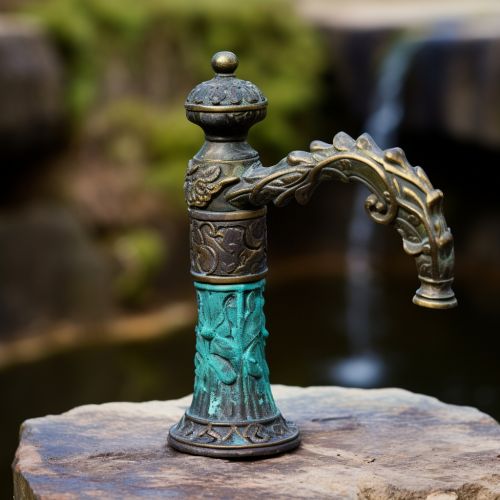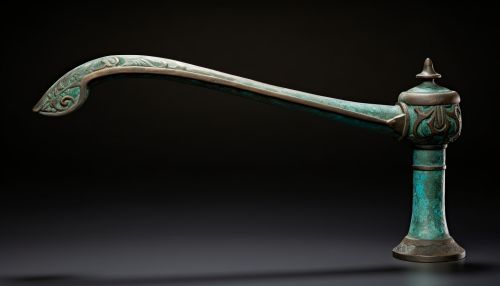Bathroom Faucet
Introduction
A bathroom faucet, also known as a tap in some regions, is a device that controls the flow of water from a supply pipe into a sink, bathtub, or shower. The primary components of a bathroom faucet include the spout, handles, and valves. The spout is the part of the faucet where the water exits, while the handles control the flow and temperature of the water. The valves, located within the faucet, regulate the water flow when the handles are turned Valve.
History
The history of bathroom faucets dates back to ancient civilizations. The Romans, for example, used elaborate systems of aqueducts and pipes to deliver water to public baths and private homes. These early faucets were typically made of bronze or lead and operated by turning a handle or lever Ancient Rome.


In the 19th century, with the advent of modern plumbing systems, bathroom faucets became more standardized and widely used. The first patent for a faucet that could deliver both hot and cold water was granted in 1880 to a man named Al Moen. This invention revolutionized the plumbing industry and set the standard for modern bathroom faucets Plumbing.
Types of Bathroom Faucets
There are several types of bathroom faucets, each with its own unique features and benefits. These include single-handle faucets, double-handle faucets, wall-mounted faucets, and touchless faucets.
Single-Handle Faucets
Single-handle faucets have one handle that controls both the water temperature and flow rate. The handle is typically located on top of the spout or to its side. These faucets are easy to use and install, making them a popular choice for many homeowners Single-Handle Faucet.
Double-Handle Faucets
Double-handle faucets have two separate handles for hot and cold water, allowing for more precise temperature control. These faucets are often considered more traditional and can add a classic touch to a bathroom Double-Handle Faucet.
Wall-Mounted Faucets
Wall-mounted faucets are installed directly into the wall above the sink, freeing up counter space and creating a sleek, modern look. These faucets require special plumbing configurations and are typically more expensive to install than other types Wall-Mounted Faucet.
Touchless Faucets
Touchless faucets use infrared sensor technology to detect the presence of hands under the spout and automatically turn the water on or off. These faucets are hygienic and water-efficient, making them a popular choice for public restrooms and increasingly common in residential bathrooms Touchless Faucet.
Materials and Finishes
Bathroom faucets are made from a variety of materials, including brass, stainless steel, and plastic. The material used can affect the faucet's durability, cost, and aesthetic appeal.
Brass is a common material for bathroom faucets due to its durability and resistance to corrosion. Stainless steel faucets are also durable and resistant to corrosion, but they are typically more expensive than brass faucets. Plastic faucets are the least expensive option, but they are also less durable and may not last as long Brass, Stainless Steel, Plastic.
In addition to the material, bathroom faucets also come in a variety of finishes, including chrome, nickel, bronze, and brass. The finish can significantly impact the faucet's appearance and maintenance requirements. For example, chrome finishes are shiny and easy to clean, while bronze finishes offer a more rustic look but may require more maintenance to prevent tarnishing Chrome, Nickel, Bronze, Brass Finish.
Installation and Maintenance
Installing a bathroom faucet involves connecting the faucet to the water supply lines, securing it to the sink or wall, and ensuring that it operates correctly. This process can be complex and may require the assistance of a professional plumber, especially for wall-mounted or touchless faucets Plumber.
Maintenance of a bathroom faucet typically involves regular cleaning to prevent mineral buildup and the occasional replacement of worn-out parts. Some faucets may also require periodic resealing to prevent leaks Sealant.
Environmental Considerations
Many modern bathroom faucets are designed with water efficiency in mind to conserve water and reduce utility bills. These faucets often have aerators that mix air with the water flow to reduce water usage without compromising performance. Some faucets are also equipped with flow restrictors that limit the amount of water that can flow through the faucet per minute Aerator, Flow Restrictor.
In addition, touchless faucets can help conserve water by automatically shutting off the water flow when not in use. This feature can be particularly beneficial in public restrooms, where faucets are often left running Touchless Faucet.
See Also
Kitchen Faucets Shower Heads Plumbing Fixtures
